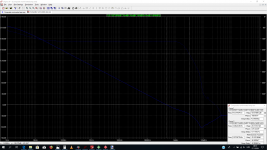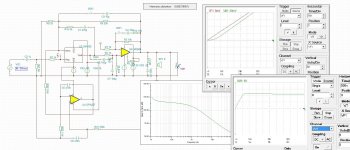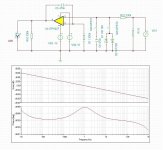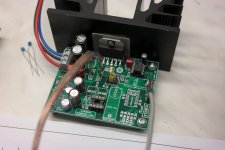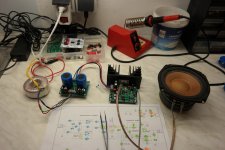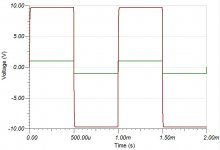Could you tell me some details please!?
Answered to your previous question, the speaker as "8Ω in parallel with 1uF" is a bit extreme. I have no passive xover, only the cable has some capacitance but sure not 1uF...
Answered to your previous question, the speaker as "8Ω in parallel with 1uF" is a bit extreme. I have no passive xover, only the cable has some capacitance but sure not 1uF...
Last edited:
You notice that The Modulus doesn't need sofisticated music to go dist........ lets say Industrial sounding .
I do not really understand this...
Where did you get the "full discrete LM3886 spice model, not some mockup macromodel" ? How do you know it is correct?
Where did you get the "full discrete LM3886 spice model, not some mockup macromodel" ? How do you know it is correct?
I built it myself ones I figured out that equivalent basic schematic given in various Overture series datasheet is not complete (as expected) and is not fully correctly drawn (knowingly?). For example, you will never get LF gain over 90dB with heavy 1k1 LTP emitter resistor given in simplified equivalent schematic from datasheet without some intervention somewhere else. Another example is an diode loaded PNP driver to the lower half output stage...it is not an diode, it is an NPN transistor that behaves as diode at certain frequency.😉
Is my spice model correct you ask...no it is not...if for nothing else (as far as I know) it is not possible to have transistors with multiple emitters or collectors in spice which are surely present in real amplifier for various duty.
Kokoriantz,
Dude, you're trying to use Youtube videos with sound recorded in MP3 and a Spice simulation to prove that an amp with 0.0003% distortion sounds bad, that's funny.
Dude, you're trying to use Youtube videos with sound recorded in MP3 and a Spice simulation to prove that an amp with 0.0003% distortion sounds bad, that's funny.
Quite. The Parallel-86 sounds very good playing ASD2990 - Walton 2nd symphony conducted by Previn - and that is not exactly sparse girl and guitar stuff.
Is it normal if the DC-servo transfer characteristich turns into negativ at high frequencies?
Its doesn't turn negative, its falling relentlessly. You don't understand logarithmic units like decibels.
Since I am not familiar with TINA, could you place as a load 8Ω in parallel with 1uF (instead of speaker) and repeat the step response in +/- directions?
Answered to your previous question, the speaker as "8Ω in parallel with 1uF" is a bit extreme. I have no passive xover, only the cable has some capacitance but sure not 1uF...
I asked for this because I wanted to see what the output signal would look like if the output was capacitive loaded ... start with 100n and up to 1u in // with 8R and watch how fast (or not) the amplifier will damp the ringing in simulator.🙂
Edit: I just realized that you have a working prototype so you can try in flesh. Did you use the component values that I suggested that might be ok?
Last edited:
Yes, I have a working version (now even 2). I've soldered the DC-servo part together too, and works great. Only the balanced receiver (instrumentation amplifier) is not tested yet.
I had some problems with clipping oscillating, but it has been solved. It was an intresting story, because I used an old notebook for testing. The audio part of the notebook electronics is in standby modus, and as it wakes up when I start the playing, gives a huge transient signal, big enough to clip the amps. Without a proper setup the amp starts to oscillate in the HF range, you are unable to hear it. I saw only on the power meter what showed about 50-60W instead of 8W (standby consumption of the 2 amps), and my 30VA trafo began to heating up! But the good news, there is a solution fot that...🙂
The amp is really special, sounds more airy, and simply more natural as the basic LM3886. Easy to listen... Comes practical zero noise out from the speaker, even if I put my ear in that. I've tried it with my main system too, but only in the mid-high range (>700Hz by the LXmini+2). Convincing...
The mid-bass section would be driven in bridged config because of they are 8 Ohm speakers and needs more power. So I have to finish another 4 pcs. and will order a big custom made 300-400VA toroidal trafo with 4x 20V sec.
Summarized, I can recommend the amp! Buy it from Tom (thanks for the design!!), or make yourself one, the challange and fun is definitive there...🙂
I had some problems with clipping oscillating, but it has been solved. It was an intresting story, because I used an old notebook for testing. The audio part of the notebook electronics is in standby modus, and as it wakes up when I start the playing, gives a huge transient signal, big enough to clip the amps. Without a proper setup the amp starts to oscillate in the HF range, you are unable to hear it. I saw only on the power meter what showed about 50-60W instead of 8W (standby consumption of the 2 amps), and my 30VA trafo began to heating up! But the good news, there is a solution fot that...🙂
The amp is really special, sounds more airy, and simply more natural as the basic LM3886. Easy to listen... Comes practical zero noise out from the speaker, even if I put my ear in that. I've tried it with my main system too, but only in the mid-high range (>700Hz by the LXmini+2). Convincing...
The mid-bass section would be driven in bridged config because of they are 8 Ohm speakers and needs more power. So I have to finish another 4 pcs. and will order a big custom made 300-400VA toroidal trafo with 4x 20V sec.
Summarized, I can recommend the amp! Buy it from Tom (thanks for the design!!), or make yourself one, the challange and fun is definitive there...🙂
Last edited:
Sim
Here a simulation with 1uF II 8 Ohm, drived with 1kHz, 2Vp-p square signal.
THD: 0,0008% (1kHz, 4Vp-p sinus)
Here a simulation with 1uF II 8 Ohm, drived with 1kHz, 2Vp-p square signal.
THD: 0,0008% (1kHz, 4Vp-p sinus)
Attachments
Last edited:
Is it normal if the DC-servo transfer characteristich turns into negativ at high frequencies?
Decibels are ratios. Negative decibels mean gain < 1, attenuation. Nothing to do with the sign of the signal.
Jan
Here a simulation with 1uF II 8 Ohm, drived with 1kHz, 2Vp-p square signal.
Perfect...now try the same with real McCoy and prepare yourself to see some nasty stuff😉
- Home
- Amplifiers
- Chip Amps
- LM3886 & LME49720 composite amp
